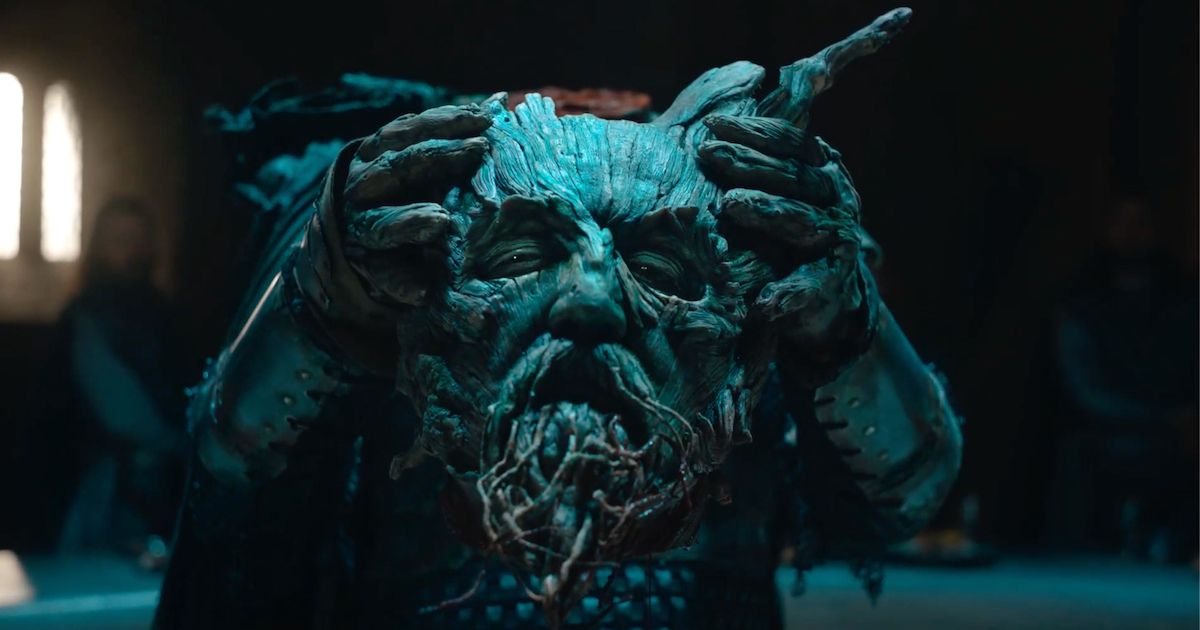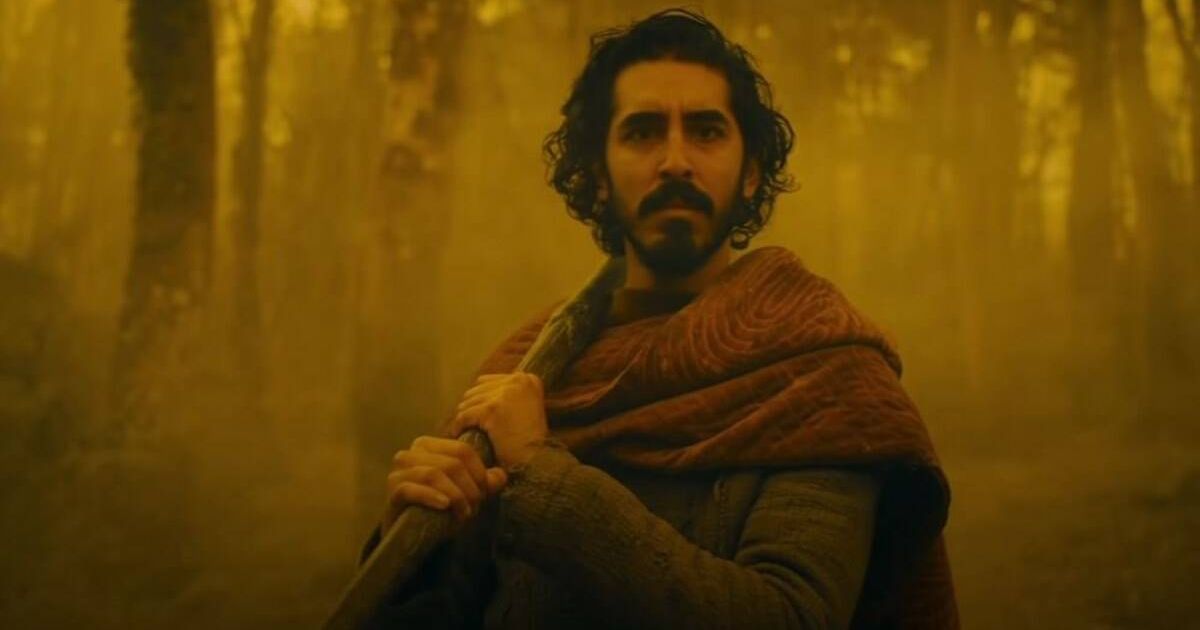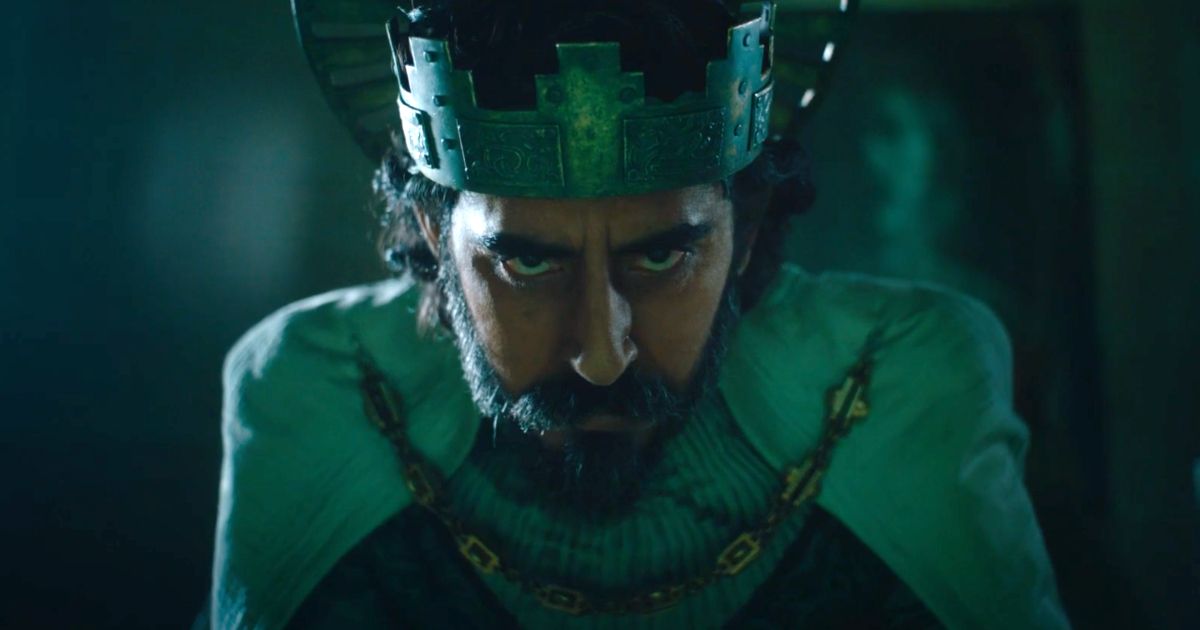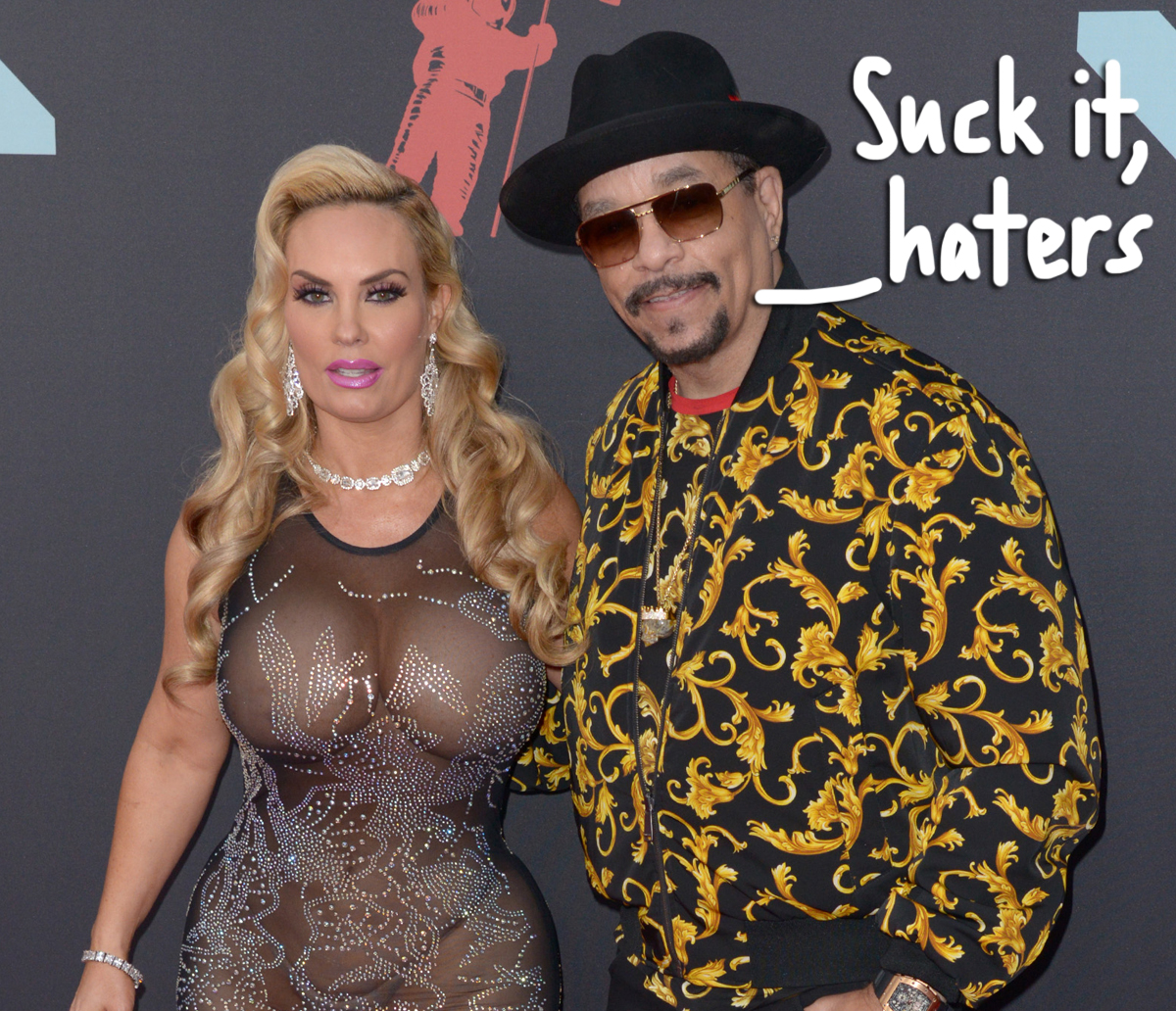#How The Green Knight Uses Arthurian Legend to Discuss the 21st Century

Table of Contents
“How The Green Knight Uses Arthurian Legend to Discuss the 21st Century”
While many examples of this kind of commentary can be found throughout filmmaking in the “new normal” (The Matrix: Resurrections, tick, tick… BOOM! to name a few), director David Lowery has crafted what could only possibly be defined as the ‘Modern Hero’s Journey’ with his great A24 fantasy film, 2021’s The Green Knight.
Gawain: Black Sheep of the Round Table
The film centers around Dev Patel’s Sir Gawain, a Knight of the Round Table and nephew to King Arthur. Canonically, Gawain and Arthur are close confidants, but this adaptation prefers to see him as a man whose title may exceed his qualifications. Initial exposure shows he knows little of nobility. What he does know of, however, is indulgence — he is awoken in a brothel, still smelling of booze and poor decisions from the previous evening. In one of our first interactions with the character we’re shown his embarrassment when unable to present the King with a story fit for a Knight.
This embarrassment, this yearning for greatness and discontent with what life has presented our protagonist prior to this, is what flings our story into action. After this, Gawain, above all others, accepts the challenge of the Green Knight: give a blow, receive one of equal severity. Simple enough, right? One would assume, until Gawain cuts the Green Knight’s head clean off, while wielding what the viewer is left to infer is Excalibur. It is then that the viewer observes the blind ambition that fuels our main character, and now we must patiently wait just as he does in order to see where that ambition leads. Gawain is a man surrounded by men of honor, and finally is met with the opportunity to bring it upon himself. That is, if he survives.
A More Realistic Hero’s Journey
Like all great tales of old, Gawain’s journey is as (if not more) important than his destination. He’s met by robbers, spirits, and other mysterious figures (which we’ll get to later) that all seek to delay his journey to meet his fate. His first brush with death, when he is met by scavengers, is where Gawain’s true colors are shown. These inward colors do not quite reflect his outside appearance of nobility, as stated by those who rob him. With this they take Gawain’s worldly possessions, items that brand him of the status he aspires for but has not yet earned. With this, his Death is recognized but coped with, as he continues on his journey.
As his quest increases in fervor and his senses decrease in integrity, Gawain is introduced to the spirit Winifred. A famous character in Catholic lore, Winifred explains that our hero’s next challenge is retrieving her head from within the lake residing beside them (you can’t have fantasy without blatant foreshadowing). While Gawain completes this with ease, he too quickly asks for a gift in return (“too quickly” here meaning he asks even before his task is completed). Just as he did with the scavengers, and as he will continue to do until his lesson is realized, Gawain attempts to salvage the spoils of glory before seeing how those must be won outright.
Our hero is still in the ring with fate, a match that an outsider knows can’t be won, but the human nature of its newest victim is too afraid to admit this truth. With this new task now complete, however, we see the Green Knight’s axe returned to the man who won it that quick year ago. With this he embarks, and his findings are as delirious as his mind is at this point in the journey. Gawain is met by giants, an addition accurate to its source material, yet upon first viewing seemingly out of place.
The Green Knight Reflects a New Youth
According to the director, the giants are meant to represent the old natural world, one of Arthurian legends, leaving Earth behind as it advances, and the age of man sees its conception realized. While you could tie the ribbon on it here, it’s likely that these giants mean more to Gawain than just a side effect of his madness. These creatures leaving him behind are representative of his protection (the sash gifted by his mother), eventually becoming something of a relic to him. Once his fear of mortality is conquered, there is no need to brandish a shield of any form to keep him safe.
Gawain eventually finds his way to safe shelter, among the company of a Lord and Lady not far off from where his journey is to end. Strangely enough, the Lady in question is played by Alicia Vikander, along with her role in the film as Essel. While never stated outright, it’s clear that Gawain can see the two’s extreme resemblance and thus our third challenge for our hero arrives. The last test of his youth: lust. To the surprise of no one, he fails at this as well, succumbing to temptation as a last resort to restore his fervor. With it, however, we find that he is then given back the sash of which he lost to those robbers in the woods, showing that temporary pleasures grant a temporary escape.
The consequences of both infidelity and avoiding one’s own destiny will eventually make their way back to the source of which it came. It’s within the halls of this new home that we also see a new game proposed, echoing that of the Green Knight’s looming return. The Lord says to Gawain that he shall receive the spoils of his hunt, if Gawain is to find something within the castle of worth. While the viewer sees this as the sash later revealed, it is either unbeknownst to Gawain or a fact held in denial as he departs. He leaves with the protection granted to him, as well as the good graces of new friends. Again, our “hero” is looking for the easy way out.
Destiny’s True Colors
At long last, Gawain and the Green Knight meet once again, and yet again, in the face of his own destiny (death), Gawain nearly shies away from the task given to him so long ago. Throughout this entire film, The Green Knight begs the classic question: would you want to know how and when you die? For Gawain, he was not afforded its secrecy, and this in turn shows how fragile our own mortality is; when faced with it the way he is, it terrifies us. It terrifies Gawain so much that for a brief moment he considers escape, living a false life away from the fate carved out for him.
It’s in his final moments that he takes off the sash (the symbol of his youthful idea of immortality) and is ready to truly meet the end he set for himself. It’s at this moment that our hero’s journey is realized. Not in the actions he took to get to this place, but his final intent and discovery of bravery. In that final moment as the end swiftly approaches, Gawain has won. He has tried to take every shortcut to victory up to this point, but it’s with an axe aimed for his neck that he realizes destiny, and even greatness, is not generous to those who cut corners.
Arthurian Legend in the 21st Century
What makes this film truly great is its ability to state themes that have held true in literature for hundreds of years, while also allowing a modern storyteller to plant the struggles of its modern audience into the soil it waters throughout its runtime. For starters, our protagonist is a mostly directionless individual upon our first meeting with him. He drinks in excess, he sleeps around, and he clearly hasn’t done much in the way of proving he has a worthy seat at his uncle’s table.
Gawain recognizes this, but instead of realizing himself traditionally he throws himself at the first opponent he sees, ultimately sealing his fate. This rush to greatness then takes the protagonist through trials and tribulations that could have very well been avoided by a man wiser than him.
Heroism According to David Lowery
Where this film truly takes shape is with its messaging about the concepts of aspiration and purpose under Arthurian legend, and transforming this into a commentary on contemporary youth and attitudes. These legends and source material for The Green Knight, a form of storytelling characterized by its surrender of worldly ideals in exchange for a path carved out for its heroes by omniscient architects of destiny, is totally abandoned by Lowery’s rendition of the prose. For a 21st century audience whose destiny is entirely self-dependent, this almost archaic notion of a bigger picture becomes not only unrealistic but discouraging.
Unlike our aforementioned heroes of old, purpose is rarely granted to those who desire it from some holy revelation. A maddening realization for a generation told that the world would accommodate their desires, rather than them having to accomplish societal goals before their own. For Sir Gawain and the generation of wannabe heroes he reflects, true purpose is found in application rather than scale. Whether this be an untimely realization of what heroics truly look like or acceptance of miniscule meaning, Lowery’s The Green Knight ultimately displays that the true tell of character isn’t in accomplishment, it’s in attitude.
If you liked the article, do not forget to share it with your friends. Follow us on Google News too, click on the star and choose us from your favorites.
For forums sites go to Forum.BuradaBiliyorum.Com
If you want to read more Like this articles, you can visit our Social Media category.

.jpg)
.jpg)







